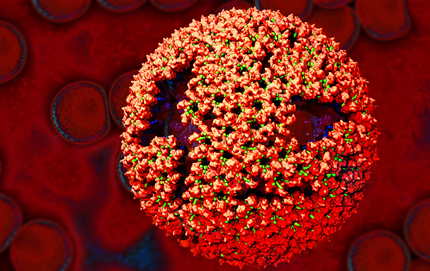Snapshots of Life: Imperfect but Beautiful Intruder
Posted on by Dr. Francis Collins

Credit: Boon Chong Goh, Beckman Institute, University of Illinois at Urbana-Champaign
The striking image you see above is an example of what can happen when scientists combine something old with something new. In this case, a researcher took the Rous sarcoma virus (RSV)—a virus that’s been studied for more than century because of its ability to cause cancer in chickens and the insights it provided on human oncogenes [1, 2]—and used modern computational tools to generate a model of its atomic structure.
Here you see an immature RSV particle that’s just budded from an infected chicken cell and entered the avian bloodstream. A lattice of proteins (red) held together by short peptides (green) cover the outer shell of the immature virus, shielding other proteins (blue) that make up an inner shell.
The image is the creation of Boon Chong Goh, a graduate student in the NIH-supported lab of Klaus Schulten in the Beckman Institute at the University of Illinois at Urbana-Champaign. Goh named the image “Imperfect Intruder” because the immature virus is still in its noninfectious stage. As the particle matures, the short peptides (green) will be cut from the outer lattice (red), allowing a total rearrangement of the particle into a closed spherical structure. Until then, the imperfect intruder is especially vulnerable to drugs that block its maturation. Goh’s knack for building sophisticated viral models is not only of potential interest to the poultry industry, but to research on the human immunodeficiency virus (HIV), which is quite similar in structure to RSV.
To make this image, Goh analyzed existing structural data on RSV proteins and developed algorithms to model their atomic structures. He then entered his draft algorithms into sophisticated software programs called Nanoscale Molecular Dynamics (NAMD) and Visual Molecular Dynamics (VMD), the development of which NIH has supported for more than 25 years at the Beckman Institute. NAMD performs the actual calculations, and VMD prepares the simulation, analyzes the results, and provides fodder for Goh to refine his calculations.
One day, Goh entered his latest algorithm into a video simulator in VMD and, remarkably, the image above popped up within 10 to 15 seconds. Goh really liked what he saw and later photo-shopped in the background image of the chicken red blood cells to convey that the immature RSV circulates through the blood system. And voila! He had an eye-catching model worthy of taking home high honors in the Biophysical Society’s annual “Art of Science” image contest.
References:
[1] A humble chicken virus that changed biology and medicine. Vogt PK, Lancet Oncol. 2009 Jan;10(1):96.
[2] 100 years of Rous sarcoma virus. Weiss RA1, Vogt PK. J Exp Med. 2011 Nov 21;208(12):2351-5
Links:
Theoretical and Computational Biophysics Group (Beckman Institute, University of Illinois)
Video: Chemical Visualization of Human Pathogens: The Retroviral Capsids (Beckman Institute)
Art of Science Image Contest (Biophysical Society, Bethesda, MD)
NIH Support: National Institute of General Medical Sciences

Is this R. sarcoma virus which can cause cancer in chickens related in any way to the soft tissue sarcoma and/or osteosarcoma found in humans?
Thanks for your question. The experts at the National Cancer Institute note that the Rous Sarcoma virus of chickens carries a potent oncogene called v-src. It is an activated form of a proto-oncogene found in the genomes of chickens and also in mammals, including humans. Viruses carrying this oncogene have not been identified in humans. However, the src gene is activated or over expressed in a wide array of human tumors, including some sarcomas. Clinical trials involving drugs that inhibit src are underway or have been completed for multiple cancers, including a limited number involving sarcomas. A recently completed trial found than one of these src inhibitors, dasatinib, had activity as single agents in patients with one specific type of sarcoma, undifferentiated pleomorphic sarcoma, but was inactive in six other sarcoma types that were examined.